Shopping by Mail
| |
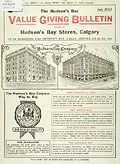 |
|
| |
 Hudson's
Bay Company (Calgary), Value Giving Bulletin, July 1922, cover. Hudson's
Bay Company (Calgary), Value Giving Bulletin, July 1922, cover.
|
|
| |
|
|
|
The HBC provided a personal shopping service, through which rural
customers
made requests directly to the head of what was called the mail-order
department.
Burbidge also tried to appeal to the "country trade," within an
80-
to 120-kilometre [50- to 75-mile] radius of each store. He tried various
strategies,
including paying transportation costs through credit on purchases.
Individual
stores provided seasonal leaflets and price lists of groceries, liquor,
and tobacco.
Some stores issued monthly bulletins that included price lists for staples
such
as groceries, seeds, and cleansers, and a very limited selection of
clothing,
furnishings, and household textiles, just enough to let customers know the
range
of goods that could be purchased through the personal shopper.
| |
 |
|
| |
 Calgary
store, ca 1910s. Calgary
store, ca 1910s.
|
|
| |
|
|
|
Calgary was considered to have the most potential as the centre for
Western
retailing in the late 1910s and 1920s. However, London shareholders
naively thought
that the retail business would always be a sideline to the fur trade and
were
reluctant to invest heavily in the development of the retail stores until
the
1920s. When management of the company shifted to Canada, the potential for
growth
in the retail business began to be understood.
Beginning in 1931, the Fur Trade Depot periodically published a
200-page
catalogue for use by its posts, listing typical merchandise carried by the
depot.
The order desk catalogue provided customers with access to a much broader
range
of goods than could be displayed within a small post. You could even buy a
Peterborough
canoe through the depot. Stores continued to provide shopping by mail, and
later
by telephone, for customers who found it inconvenient to get to the
stores.
| |
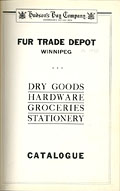 |
|
| |
 Hudson's
Bay Company, Fur Trade Depot Catalogue, ca 1934, cover. Hudson's
Bay Company, Fur Trade Depot Catalogue, ca 1934, cover.
|
|
| |
|
|
|
|
| |
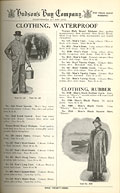 |
|
| |
 Hudson's
Bay Company, Fur Trade Depot Catalogue, ca 1934, p. 23. Hudson's
Bay Company, Fur Trade Depot Catalogue, ca 1934, p. 23.
|
|
| |
|
|
|
|
| |
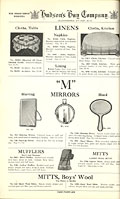 |
|
| |
 Hudson's
Bay Company, Fur Trade Depot Catalogue, ca 1934, p. 46. Hudson's
Bay Company, Fur Trade Depot Catalogue, ca 1934, p. 46.
|
|
| |
|
|
|
|
| |
|
|
| |
 |
|
| |
 Hudson's
Bay Company, Fur Trade Depot Catalogue, ca 1934, p. 79. Hudson's
Bay Company, Fur Trade Depot Catalogue, ca 1934, p. 79.
|
|
| |
|
|
|
|
| |
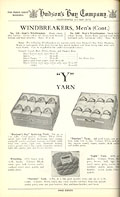 |
|
| |
 Hudson's
Bay Company, Fur Trade Depot Catalogue, ca 1934, p. 90. Hudson's
Bay Company, Fur Trade Depot Catalogue, ca 1934, p. 90.
|
|
| |
|
|
|
|
| |
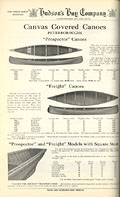 |
|
| |
 Hudson's
Bay Company, Fur Trade Depot Catalogue, ca 1934, p. 112. Hudson's
Bay Company, Fur Trade Depot Catalogue, ca 1934, p. 112.
|
|
| |
|
|
|
|
|
Conclusion
Although never a major force in the mail-order business, the
Hudson's
Bay Company's retail empire expanded throughout the 20th century. In
later
years, acquisitions and mergers intertwined its history with those of
other former
mail-order companies such as Morgan's (1960), Simpson's
(1978), and
Woodward's (1993).
|
|
Further Reading
Little has been written about the retail and mail-order history of the
Hudson's
Bay Company. Therefore, researchers must refer to the annual reports,
bulletins,
catalogues, correspondence, and publications such as Bay News and
The
Beaver in the Hudson's Bay Company Archives (HBCA) in Winnipeg.
To
find out more about the HBCA, visit their website at http://www.gov.mb.ca/chc/archives/hbca/.
|